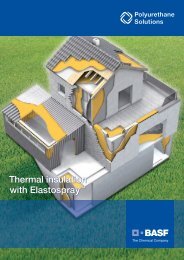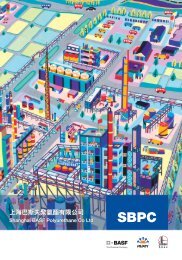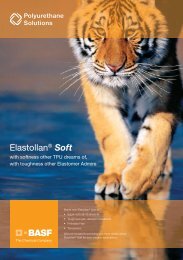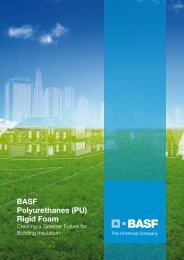Download - BASF Polyurethanes Asia Pacific
Download - BASF Polyurethanes Asia Pacific
Download - BASF Polyurethanes Asia Pacific
Create successful ePaper yourself
Turn your PDF publications into a flip-book with our unique Google optimized e-Paper software.
Automotive<br />
Composite Materials<br />
Breaking the mold with LFI.<br />
<strong>BASF</strong> has been energetically pursuing the development<br />
of LFI technology for vehicle components<br />
in buses, trucks, special-purpose machinery and<br />
cars since 2006.<br />
<strong>BASF</strong> <strong>Asia</strong> <strong>Pacific</strong> is now celebrating<br />
success with the application of this<br />
technology in China as well. An<br />
important customer here is Yangzi<br />
Motor Decoration Company Ltd.<br />
Long fiber injection (LFI) is used in<br />
this field to reinforce light and strong PU parts with long glass fibers – the<br />
instrument panel carrier material in the new Scania buses, for example. In an<br />
LFI system, glass fibers are cut from a reel and chopped into superfine fibers<br />
that are then mixed with the PU reaction system. The mix is then fed into an<br />
open mold. The mold is closed and the component is formed under pressure,<br />
with the glass fibers and PU system combining to yield an extra-strong composite<br />
material.<br />
Quicker, harder, more durable and ultimately cheaper. Every production<br />
step benefits from the LFI process.<br />
Long-fiber-reinforced PU comes with a host of significant advantages. These<br />
include new design scope for interior and exterior parts. By modifying various<br />
machine parameters, it is even possible to change the material’s mechanical<br />
characteristics in some cases. With the aid of various decorative materials<br />
(PVC, TPO, ASA/PC, to name but a few), it’s possible to adapt the surface to<br />
the application in question. This means appreciable savings in expenditure<br />
and time – firstly, through the use of inexpensive glass fiber filaments, with<br />
reduced waste thanks to optimized distribution by robot. The cutting and preforming<br />
of the glass fiber mats is no longer necessary. And secondly, the<br />
individual components no longer have to be produced in a laborious manual<br />
lamination process. Now all it takes is a single work cycle, even for compo nents<br />
with extra-large surfaces. To this end, an already thermoformed thermoplastic<br />
sheet is laid in the mold, and the polyurethane – in this case Elastoflex ® E – and<br />
finely chopped glass fibers are laid on top. Then the mold is closed, the material<br />
cures, metal reinforcements and fasteners are fitted to the inside, and the<br />
new Scania component is finished. The process couldn’t be faster or more<br />
precise.<br />
Further information: www.scania.com<br />
Contact: Jan Yang, <strong>BASF</strong> <strong>Polyurethanes</strong> Specialties, <strong>BASF</strong> <strong>Asia</strong> <strong>Pacific</strong>, Shanghai,<br />
China, e-mail: jan.yang@basf.com<br />
18
















